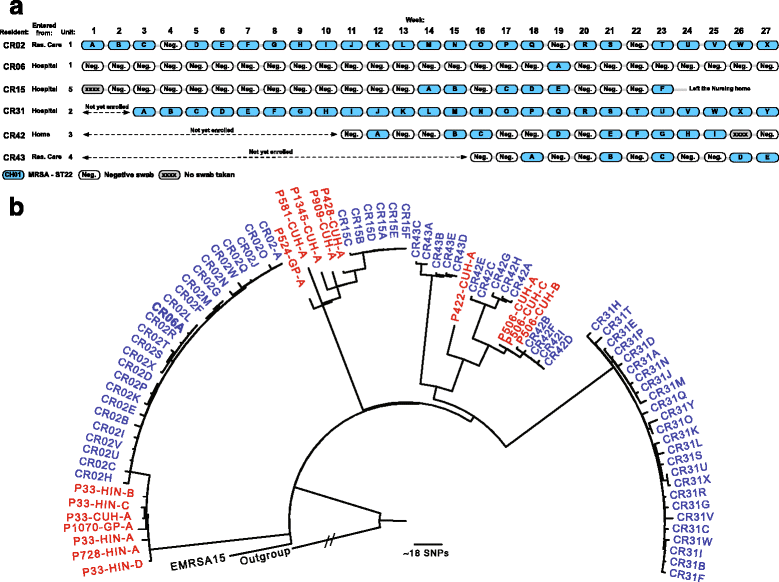Transmission of methicillin-resistant Staphylococcus aureus in long-term care facilities and their related healthcare networks
- PMID: 27716432
- PMCID: PMC5048656
- DOI: 10.1186/s13073-016-0353-5
Transmission of methicillin-resistant Staphylococcus aureus in long-term care facilities and their related healthcare networks
Abstract
Background: Long-term care facilities (LTCF) are potential reservoirs for methicillin-resistant Staphylococcus aureus (MRSA), control of which may reduce MRSA transmission and infection elsewhere in the healthcare system. Whole-genome sequencing (WGS) has been used successfully to understand MRSA epidemiology and transmission in hospitals and has the potential to identify transmission between these and LTCF.
Methods: Two prospective observational studies of MRSA carriage were conducted in LTCF in England and Ireland. MRSA isolates were whole-genome sequenced and analyzed using established methods. Genomic data were available for MRSA isolated in the local healthcare systems (isolates submitted by hospitals and general practitioners).
Results: We sequenced a total of 181 MRSA isolates from the two study sites. The majority of MRSA were multilocus sequence type (ST)22. WGS identified one likely transmission event between residents in the English LTCF and three putative transmission events in the Irish LTCF. WGS also identified closely related isolates present in colonized Irish residents and their immediate environment. Based on phylogenetic reconstruction, closely related MRSA clades were identified between the LTCF and their healthcare referral network, together with putative MRSA acquisition by LTCF residents during hospital admission.
Conclusions: These data confirm that MRSA is transmitted between residents of LTCF and is both acquired and transmitted to others in referral hospitals and beyond. Our data present compelling evidence for the importance of environmental contamination in MRSA transmission, reinforcing the importance of environmental cleaning. The use of WGS in this study highlights the need to consider infection control in hospitals and community healthcare facilities as a continuum.
Keywords: Long-term care facilities; MRSA; Molecular epidemiology; Nursing home; Staphylococcus aureus; Transmission; Whole-genome sequencing.
Figures


Similar articles
-
Investigation of a Cluster of Sequence Type 22 Methicillin-Resistant Staphylococcus aureus Transmission in a Community Setting.Clin Infect Dis. 2017 Nov 29;65(12):2069-2077. doi: 10.1093/cid/cix539. Clin Infect Dis. 2017. PMID: 29077854 Free PMC article.
-
Transmission of methicillin-resistant Staphylococcus aureus in the long term care facilities in Hong Kong.BMC Infect Dis. 2013 May 6;13:205. doi: 10.1186/1471-2334-13-205. BMC Infect Dis. 2013. PMID: 23641974 Free PMC article.
-
Transmission Clusters of Methicillin-Resistant Staphylococcus Aureus in Long-Term Care Facilities Based on Whole-Genome Sequencing.Infect Control Hosp Epidemiol. 2016 Jun;37(6):685-91. doi: 10.1017/ice.2016.41. Epub 2016 Mar 4. Infect Control Hosp Epidemiol. 2016. PMID: 26941060
-
Methicillin-resistant Staphylococcus aureus in long-term-care facilities.Clin Microbiol Infect. 2009 Dec;15 Suppl 7:26-30. doi: 10.1111/j.1469-0691.2009.03093.x. Clin Microbiol Infect. 2009. PMID: 19951331 Review.
-
Has decolonization played a central role in the decline in UK methicillin-resistant Staphylococcus aureus transmission? A focus on evidence from intensive care.J Antimicrob Chemother. 2011 Apr;66 Suppl 2:ii41-7. doi: 10.1093/jac/dkq325. Epub 2010 Sep 18. J Antimicrob Chemother. 2011. PMID: 20852273 Review.
Cited by
-
Colonization and transmission of Staphylococcus aureus in schools: a citizen science project.Microb Genom. 2023 Apr;9(4):mgen000993. doi: 10.1099/mgen.0.000993. Microb Genom. 2023. PMID: 37074324 Free PMC article.
-
Infection control in long term care institutions for the elderly: A reflection document on the situation in Spain.Rev Esp Quimioter. 2023 Aug;36(4):346-379. doi: 10.37201/req/002.2023. Epub 2023 Mar 29. Rev Esp Quimioter. 2023. PMID: 36987393 Free PMC article. Review.
-
Molecular epidemiology of methicillin resistant Staphylococcus species in healthcare workers of a blood bank in the Brazilian Amazon.BMC Microbiol. 2021 Nov 4;21(1):306. doi: 10.1186/s12866-021-02365-1. BMC Microbiol. 2021. PMID: 34736414 Free PMC article.
-
Framing Bacterial Genomics for Public Health (Care).J Clin Microbiol. 2021 Nov 18;59(12):e0013521. doi: 10.1128/JCM.00135-21. Epub 2021 Jun 2. J Clin Microbiol. 2021. PMID: 34076468 Free PMC article.
-
Association between length of residence and prevalence of MRSA colonization among residents in geriatric long-term care facilities.BMC Geriatr. 2020 Nov 18;20(1):481. doi: 10.1186/s12877-020-01885-1. BMC Geriatr. 2020. PMID: 33208107 Free PMC article.
References
-
- Data on S. aureus/MRSA bloodstream infections from acute hospitals, 2004 – Q1 2016. http://www.hpsc.ie/AZ/MicrobiologyAntimicrobialResistance/EuropeanAntimi.... Accessed 26 Aug 2016.
-
- NHS Commissioning Board. Everyone Counts: Planning for Patients 2013/14. https://www.england.nhs.uk/everyonecounts/.
Publication types
MeSH terms
Substances
Grants and funding
LinkOut - more resources
Full Text Sources
Other Literature Sources
Medical

